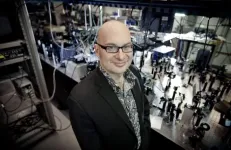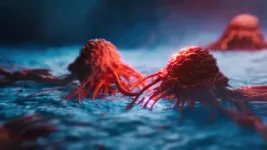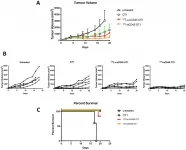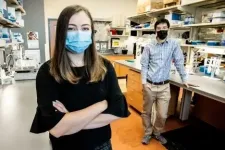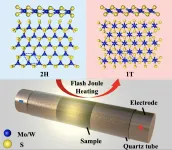(Press-News.org) Scientists from the University of Bath have made a sustainable polymer using the second most abundant sugar in nature, xylose.
Not only does the new nature-inspired material reduce reliance on crude oil products, but its properties can also be easily controlled to make the material flexible or crystalline.
The researchers, from the University's Centre for Sustainable and Circular Technologies, report the polymer, from the polyether family, has a variety of applications, including as a building block for polyurethane, used in mattresses and shoe soles; as a bio-derived alternative to polyethylene glycol, a chemical widely used in bio-medicine; or to polyethylene oxide, sometimes used as electrolyte in batteries.
The team says additional functionality could be added to this versatile polymer by binding other chemical groups such as fluorescent probes or dyes to the sugar molecule, for biological or chemical sensing applications.
The team can easily produce hundreds of grams of the material and anticipate that production would be rapidly scalable.
Dr Antoine Buchard, Royal Society University Research Fellow and Reader at the Centre for Sustainable and Circular Technologies, led the study.
He said: "We're very excited that we've been able to produce this sustainable material from a plentiful natural resource - wood.
"The reliance of plastics and polymers on dwindling fossil fuels is a major problem, and bio-derived polymers - those derived from renewable feedstocks such as plants - are part of the solution to make plastics sustainable.
"This polymer is particularly versatile because its physical and chemicals properties can be tweaked easily, to make a crystalline material or more of a flexible rubber, as well as to introduce very specific chemical functionalities.
"Until now this was very difficult to achieve with bio-derived polymers.
"This means that with this polymer, we can target a variety of applications, from packaging to healthcare or energy materials, in a more sustainable way."
Like all sugars, xylose occurs in two forms that are mirror images of each other - named D and L.
The polymer uses the naturally occurring D-enantiomer of xylose, however the researchers have shown that combining it with the L-form makes the polymer even stronger.
The research team has filed a patent for their technology and is now interested in working with industrial collaborators to further scale up production and explore the applications of the new materials.
INFORMATION:
The study was published in the prestigious chemistry journal Angewandte Chemie International Edition (in open access) and was funded by the Royal Society and the Engineering and Physical Sciences Research Council, part of UK Research and Innovation.
An international team of researchers, including Professor END ...
PHILADELPHIA -- (Jan. 11, 2020) -- Mutations that inactivate the ARID1A gene in ovarian cancer increase utilization of the glutamine amino acid making cancer cells dependent on glutamine metabolism, according to a study by The Wistar Institute published online in Nature Cancer. Researchers also showed that pharmacologic inhibition of glutamine metabolism may represent an effective therapeutic strategy for ARID1A-mutant ovarian cancer.
Up to 60% of ovarian clear cell carcinomas (OCCC) have inactivating mutations in the ARID1A tumor suppressor gene. These ...
Oncotarget recently published "Targeted lymphodepletion with a CD45-directed antibody radioconjugate as a novel conditioning regimen prior to adoptive cell therapy" which reported that Chimeric antigen receptor T cell therapies, and adoptive cell therapy in general, represent one of the most promising anti-cancer strategies.
In contrast to relatively non-specific chemotherapy-derived lymphodepletion, targeted lymphodepletion with radioimmunotherapy directed to CD45 may be a safer and more effective alternative to target and deplete immune cells. Here the authors describe the results ...
For the brain to learn, retain memories, process sensory information, and coordinate body movements, its groups of nerve cells must generate coordinated electrical signals. Disorder in synchronous firing can impair these processes and, in extreme cases, lead to seizures and epilepsy.
Synchrony between neighboring neurons depends on the protein connexin 36, an essential element of certain types of synaptic connections that, unlike classical chemical synapses, pass signals between neurons through direct electrical connections. For more than 15 years, scientists have debated the tie between connexin 36 and epilepsy.
Now, a team of Virginia Tech scientists led by Yuchin Albert Pan, an associate professor at the Fralin Biomedical Research ...
Many policymakers and educational institutions hope to boost their economies by stimulating students' entrepreneurial intentions. To date, most research concluded that entrepreneurship education could increase these intentions by improving the image that students have of entrepreneurship as a career option, making them see how their environment can help them become entrepreneurs or increasing their self-confidence regarding their entrepreneurial skills. However, recent studies show that even if these goals are achieved, students' entrepreneurial intentions often ...
HOUSTON - (Jan. 11, 2021) - Rice University scientists have extended their technique to produce graphene in a flash to tailor the properties of other 2D materials.
The labs of chemist James Tour and materials theorist Boris Yakobson reported in the American Chemical Society's ACS Nano they have successfully "flashed" bulk amounts of 2D dichalcogenides, changing them from semiconductors to metallics.
Such materials are valuable for electronics, catalysis and as lubricants, among other applications.
The process employs flash Joule heating -- using an electrical charge to dramatically raise the material's temperature -- to convert semiconducting molybdenum disulfide and tungsten disulfide. The duration of the pulse and select additives can also control the now-metallic products' ...
DURHAM, N.C. - A Duke-led team of scientists has developed a bio-compatible surgical patch that releases non-opioid painkillers directly to the site of a wound for days and then dissolves away.
The polymer patch provides a controlled release of a drug that blocks the enzyme COX-2 (cyclooxygenase-2,) which drives pain and inflammation. The study appears Jan. 10, 2021 in the Journal of Controlled Release.
When they started "We were making hernia meshes and different antimicrobial films," said Matthew Becker, the Hugo L. Blomquist professor chemistry at Duke, and last author on the paper. "We thought you could potentially put pain drugs or anesthetics in the film if you ...
A shapeshifting immune system protein called XCL1 evolved from a single-shape ancestor hundreds of millions of years ago. Now, researchers at the Medical College of Wisconsin (MCW) discovered the molecular basis for how this happened. In the process they uncovered principles that scientists can use to design purpose-built nanoscale transformers for use as biosensors, components of molecular machines, and even therapeutics. The findings were published today in Science. The primary and senior authors of the manuscript, respectively, are MCW researchers Acacia Dishman, MD-PhD student, and Brian Volkman, PhD, professor of biochemistry.
Molecular switches can be used to detect cancer, construct nanoscale machines, and even build cellular computers. ...
Scientists crafting a nickel-based catalyst used in making hydrogen fuel built it one atomic layer at a time to gain full control over its chemical properties. But the finished material didn't behave as they expected: As one version of the catalyst went about its work, the top-most layer of atoms rearranged to form a new pattern, as if the square tiles that cover a floor had suddenly changed to hexagons.
But that's ok, they reported today, because understanding and controlling this surprising transformation gives them a new way to turn catalytic activity on and off and make good catalysts ...
Women who use marijuana could have a more difficult time conceiving a child than women who do not use marijuana, suggests a study by researchers at the National Institutes of Health. Marijuana use among the women's partners--which could have influenced conception rates--was not studied. The researchers were led by Sunni L. Mumford, Ph.D., of the Epidemiology Branch in NIH's Eunice Kennedy Shriver National Institute of Child Health and Human Development. The study appears in Human Reproduction.
The women were part of a larger group trying to conceive after one or two prior miscarriages. Women who said they used cannabis products--marijuana or hashish--in the weeks before pregnancy, or who had positive urine tests for cannabis ...
